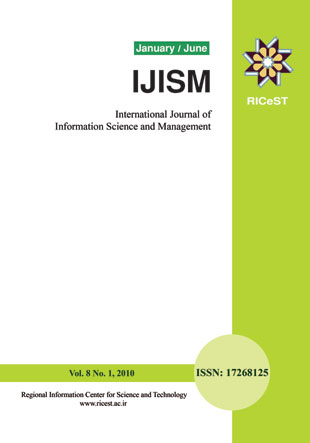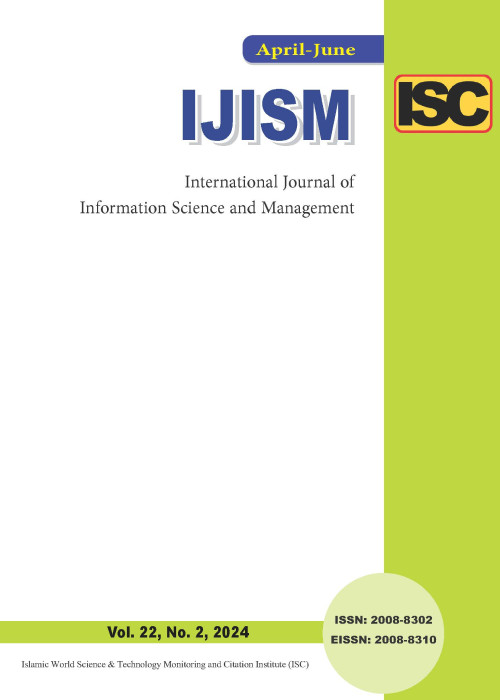فهرست مطالب

International Journal of Information Science and Management
Volume:8 Issue: 1, Jan-Jun 2010
- تاریخ انتشار: 1388/05/11
- تعداد عناوین: 7
-
-
Pages 1-19Traditional bibliometric indicators are only partially suitable for evaluating the scientific achievements of individual people. They are either not definitive or they are too complicated to use due to technical and methodological difficulties. There is still no definite evidence for the correlation between the citation rate (CPP) and the H-Index. In order to obtain a reliable assessment of what the relation is between the H-Index and the citation rate, we performed a study on 30 relevant scientists from the disciplines of "particle physics" and "neurology". The foregoing discussions on the different correlations revealed that the form and degree of correlation do not just vary considerably between the individual comparisons but also amongst the disciplines. In both disciplines, the correlation between the citation rate CPP and the H-Index was relatively low. We also found varyingdegrees of correlation here.
-
Pages 21-37Since reference practices influence Journal Impact Factor (JIF), Author Self- Citation (ASC), number of times an author cites herself / himself, and Journal Self-Citation (JSC), number of times the journal cites itself, as a portion of total citations should be considered in citation analysis. ISI provides quantitative indicators for publications in English language. Therefore, those scientific journals in different countries that publish in national languages have less chance to be evaluated based on bibliometric indicators. For this reason, Regional Information Center for Science and Technology (RICeST) affiliated to the Ministry of Science, Research and Technology of Iran started to construct the Persian Science Citation Index (PSCI) and Persian Journal Citation Reports (PJCR) as products of ISC in 2000, and released the services from 2004. PJCR and PSCI are used to conduct the research. At the time of the study 51 Persian engineering journals were indexed in ISC with IF in PJCR. The aim of the study is to find if the JIF is affected by both ASC and JSC for Persian journals in engineering subject category during 2002-2006. The results show that within the five years mean rates for JSC and ASC are 41% and 66%, respectively. Findings also report that the correlation between JSC and ASC with IF is statistically significant (R= 0.300, sig. = 0.032; R= 0.397, sig. = 0.004, respectively). Moreover, after self-citation removal, the maximum rankings change was observed (either positive or negative). With or without inclusion of author self-citations and journal self citations about 13.7% and 15.7% of journals maintained the position. There is also no correlation between JIF and the number of articles (R= - 0.031, sig. = 0.831). According to the findings, the study suggests that Persian journals'' editorial boards in engineering field implement a policy with regard to articles selection as well as authors'' citation behavior.
-
Pages 38-81The paper under review delineates the scenario, perspective and the future trends of science –Driven Entrepreneurship in the Islamic world. It digs out the factors causing the sluggishness and suggests the plan of action for the renaissance of indigenous science driven entrepreneurship with grafting of the modern scientific high tech marketing techniques on it. The paper highlights that entrepreneurship is both the cause and consequence of economic growth, technological advancement and conceptual innovations and they are interknitted, interconnected and interwoven with one-another. The economic, political, social and religious components of the society influence the science driven entrepreneurship in the Islamic World. It depicts the present situation and flashes back on the glaring Islamic era when Islamic Civilization was a beacon light and an icon scientific innovation, technological advancement and an improved entrepreneurship of that time, for the rest of the world. It was the time when almost the important seats of scientific centers were filled with Muslim Scientists and the world was hovered over with the lucrative Muslim trading networks. The paper diagnoses the pitfalls that caused the Islamic World lagging behind and provides food for the thoughts of scientists and experts pertaining to the Entrepreneurship Research and Policy Networks, the world over. It points out that all leading Muslim Scientists should have been more conscious and committed to commercializing their scientific and technological productions. It is high time for the Muslim Think Tank to synergize the efforts for thepromotion and development of scientific knowledge, technological advancement and an improved entrepreneurship. The paper concludes bysuggesting a tetra-pod model for the social reengineering process to improve the science driven entrepreneurship in the World of Islam.
-
Pages 39-49This paper presents an efficient mechanism to convert Sana’ani dialect to modern standard Arabic. The mechanism is based on morphological rules related to Sana’ani dialect as well as Modern Standard Arabic. Such rules facilitate the dialect conversion to its corresponding MSA. The mechanism tokenizes the input dialect text and divides each token into stem and its affixes; such affixes can be categorized into two categories: dialect affixes and/or MSA affixes. At the same time, the stem could be dialect stem or MSA stem. Therefore, our mechanism, implemented by using a simple MSA stemmer, must pay attention to such situations. Then our dialect stemmer is applied to strip the resulting token and extract dialect affixes. At this point, the rules are applied to decide when to carry out the extraction of an affix. The experiment shows that Sana’ani dialect has three classes of distortions, which are prefixes, suffixes, and stems distortions. The algorithm normalizes such distortion based on the morphological rules. For each morphological rule the mechanism checks possibility of applying such a rule. That means if rule conditions be met, then the dialect affix will be replaced by its corresponding MSA. If there is no restriction on applying the rule related to the distorted stem, then the rule can be considered as a parallel corpus of the dialect and MSA. Finally, the experiment computes the distortion ratio of MSA in Sana’ani dialect. For a Sana’ani dialect sample of 9386 words, 16.29% of them have distorted suffixes, 0.70% have distorted prefixes and 2.17% contain distorted stems. These percentages are related only to the processed words.
-
Pages 51-71For years, search engines have been considered as one of the most frequently used information seeking tools through the web. Efficiency, ease of use and search quality are the main factors for giving precedence over search engines. Search quality is assessed based on the concept of page rank which is applied to scoring web documents. The structures designed for linkage among the pages of a site as well as the linkage structure among the sites inside a web are known as the most effective factor on page rank. This paper is to describe the concept of ranking web pages and investigate the structure of inter-linkage of pages.
-
Pages 83-105This research aims at investigating electronic journals’ acceptance among Payam-e-Noor University faculty members as well as studying the influential factors in that. Of all faculty members approached in this study, 169 ones returned the questioners. Findings show that E-journals’ acceptance among faculty members is at average level on the basis of which it seems both printed and electronic journals have got equal positions among such a group. Findings also reveal that computer and Internet problems with the coefficient determination of ß=0/31 are the strongest factors in making E-journals not acceptable. In addition, faculty members’ computer and Internet skills with ß=0/175 and their knowledge of online full text databases with ß=0/12 make positive effects on E-journals acceptance, while access to E-journals’ causes weak effect (b=0/05). Results indicate that the more age and experience, the slighter tendency to E-journals’ use. Therefore, there is no significant correlation among gender, major, educational level and Ejournals’acceptance.
-
Assessment of Service Quality at Central Library of Management and Planning Organization (MPO), IranPages 107-118This study examines the quality of services at Iran’s Central Library of Management and Planning Organization (MPO) from the viewpoint of itsusers. The research was conducted in two phases: First, the library and its services were compared to the Standards for Special Libraries published bythe National Library of Iran (NLI). The library was found to meet most of the standards. Second, the quality of service provided by the library atexpected and observed levels was examined from the viewpoint of organizational and non-organizational members using a modified version ofthe SERVQUAL questionnaire. Findings showed a significant was difference between two (expected and observed) levels, meaning that users’expectations have not been met. The most significant difference related to “appropriate collection of information resources”. The results also showedthere was no significant difference between organizational and non-organizational users’ opinions about the quality of services. Findingsalso showed that “relevant information services” was the priority of user groups-users emphasized the need for timely and accurate information.There was a correlation between the rate at which the library conformed to the national standards and users’ expectations of quality.


